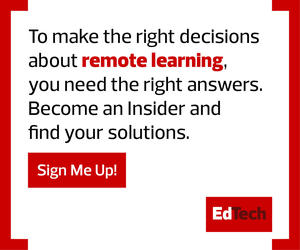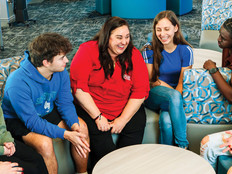DICIURCIO: What was the biggest impact you saw on customers during the pandemic?
KOCZERA: I would have to start with devices. People focused first on survival: getting that minimum viable deployment of devices out. That was the impact of 2020. In 2021, we’re going to continue to close the access gap, and it’s important that we continue to work on addressing equity. I think we’ll see schools starting to move up that digital hierarchy of needs, with support and sustainability measures for the millions of students and teachers who received devices for the first time in 2020.
SIMONE: The pressure that supply chains had — and continue to have, in some cases — was by far the biggest challenge. There were students and teachers who couldn’t access what they needed to learn, and that takes its toll on everybody in the whole circle of educational technology.
DICIURCIO: What do you hope will come from the lessons learned in the past year?
SALCITO: We want to get back to school, but we don’t want to get back to normal. We’ve got to take some of the things we’ve seen as successes in the past several months and bring them forward. There are teachers who are afraid of technology’s impact as a direct correlation with their value and role in education. Many were afraid to shift the learning environment — to give away the keys, so to speak, to the learning paradigm.
What we saw quickly was that the role of teachers became more valued and appreciated. As learning came home to the kitchen table, parents had a window into the amazing work teachers do every day. Teachers also learned how to extend the dialogue beyond the classroom. We’ve got to remember that amazing value of teachers and carry that going forward.
The way we think about the role of technology also changed. For many years, the way we have approached technology has almost been backward: We prioritized devices in the classroom, where students were around each other and their teachers. We’ve got to recognize the purposeful nature of how we leverage all our interactions and modalities.
KOCZERA: One of the lessons we’ve learned is the importance of building our technology environment for flexibility and change. What are the fundamental building blocks of classrooms or IT infrastructure, and how do you make them modular so they can be remixed as circumstances change? Buildings can be more flexible. Agile types of IT and technology can help schools be better able to pivot in the future.
DICIURCIO: What do you hear about teachers’ needs related to professional development?
KOCZERA: There are gaps between how they want PD and how they get it. What we’ve seen for students — modern learning management systems, asynchronous delivery, online portals full of rich digital content — should exist for teachers too as they skill up in this quickly changing digital landscape. What I’ve been hearing is about moving to a more flexible set of methodologies around delivery, with innovation and tools to allow teachers to learn when they want, where they want, just like we talk about with students.
DICIURCIO: What advice would you give a superintendent as we go into 2021?
KOCZERA: Continue to support your technology teams. If they aren’t part of your strategic cabinet yet, they should be. The rate of change in technology is only going to continue to increase. The entire leadership team around the superintendent needs to be aware of that, be working in partnership with your technology leadership and be modeling the change for everyone.
SIMONE: One lesson a lot of schools learned in 2020 was thinking through this whole concept of structured choice when you’re making strategic decisions: allowing choice so teams can manage solutions or initiatives, but also making sure there’s flexibility built in, so you leverage people who look across the whole industry from a technology point of view. The superintendents and the district leaders who did that benefited in 2020, and I think that’s going to continue.
SALCITO: Superintendents should expect — and, frankly, embrace — remote learning continuing when we’re back face to face. There is a danger that we’ll stop the remote learning connection and collaboration we have once students are back. But for future dynamics, such as schools closing due to snow, we have to expect that things like this could happen in the future.
Superintendents should also have a data discovery workshop with their teams. We’re seeing that data is all over the place and not being put to use. Identify all the collections of data you have and see where the connected thread is.
Read all of our TCEA 2021 coverage.











